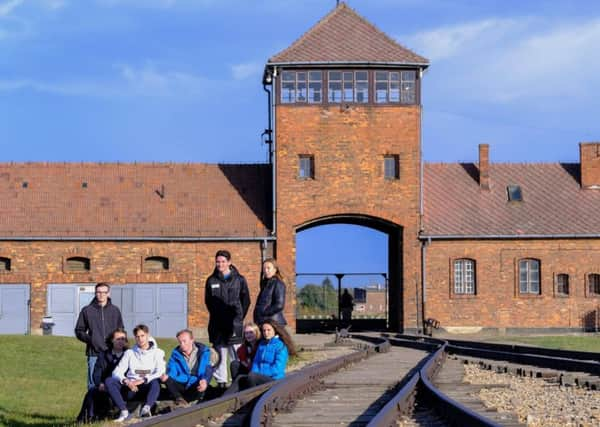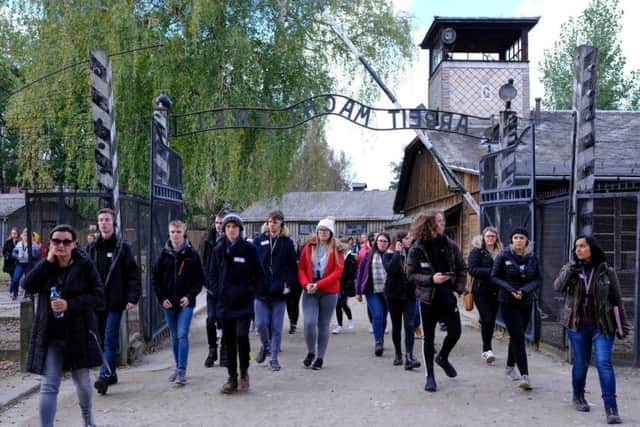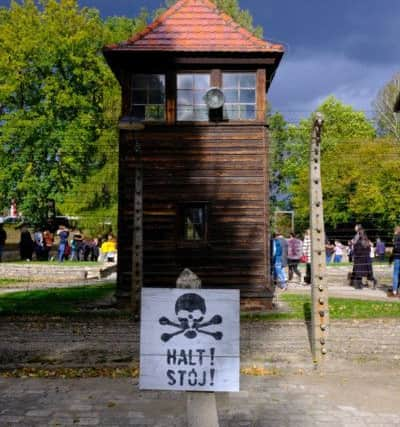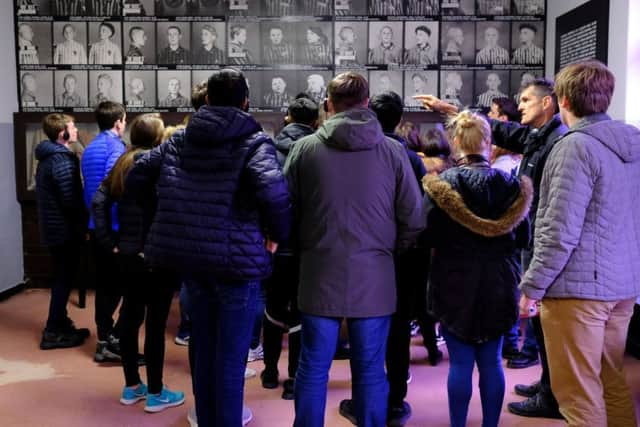Edinburgh pupils left in shock at scale of Auschwitz horror


The room is cold and dark with a shallow concrete pit in the middle where prisoners stripped before being processed by the SS guards who decided in a heartbeat if they would live a little longer or die that day in a gas chamber.
For the 200 Scottish schoolchildren who were there with the Holocaust Educational Trust (HET) to see first-hand the site of such suffering, it was the end of a long and emotional day.
Advertisement
Hide AdAdvertisement
Hide AdHuddled on the floor listening to the melodic song of a Hebrew prayer that rang out into the room just metres away from the ruins of a gas chamber, they were silent as they listened to Rabbi Andrew Shaw.


It took only 20 minutes for Zyklon B pesticide to kill the 1,500 men, women and children crammed in to a chamber by guards using clubs and dogs. It took two minutes for the first – women and children – to die.
Six million Jews were murdered in the Holocaust, and at Auschwitz, a network of three main camps and 45 sub-camps, it is estimated that 1.2 million souls were exterminated, the majority of them Jewish. The exact total is unknown as so many were slain on arrival and not entered into the camp’s records.
The aim of HET’s Lessons From Auschwitz project, now in its 19th year, is for pupils to bring what they learn from the death camps home and share it with their wider community in a bid to prevent such atrocities from re-occurring.
Advertisement
Hide AdAdvertisement
Hide AdFor the 20 teenagers from Edinburgh high schools – Balerno, Clifton Hall, Craigmount, Currie, Forrester, James Gillespie’s, Leith Academy, Liberton, Trinity Academy and Tynecastle – it was a sobering day of reflection.


Pulling up to Auschwitz 1 camp, in the Polish town of Oswiecim, flanked by the train tracks that brought prisoners to their fate and the wooden and brick barracks, the young people, aged from 16 to 18, were silent. Following guide Mariusz, they weaved through the camp wordlessly, some wiping tears from their eyes. In the 28 two-storey blocks, people slept, suffered and died from starvation, hard labour, punishment, torture and execution.
A tangle of steel-rimmed glasses lie behind a display case in Block 5.
Two tons of hair, shorn carelessly and stolen from the heads of young Jewish women lies in heaped piles. Combs, prayer shawls, prosthetic limbs, face creams and mountains of shoes represent the lives of people who were reduced to the number tattooed on their skin.
Advertisement
Hide AdAdvertisement
Hide AdRowena Edwards and Lucy Cardozo, from Trinity Academy, were most struck by the hair, cut from 40,000 female prisoners. Rowena said: “I actually cut my hair a couple of weeks ago and it was really emotional, so to see that I got quite emotional. We take so many things for granted.”


Lucy added: “All of it was very heart-hitting but it’s when you see the physical hair and shoes.. that hit home.“
A gallery of prisoner mugshots stare out from the walls of Block 11. The eyes of doctors, teachers and engineers are haunted by the cruelties they suffered. Some of the emaciated faces bear bruises and gashes, others hold their chins up in defiance.
Children were torn from their mothers in this factory of death, some murdered by doctors with a shot of Phenol straight to the heart.
Advertisement
Hide AdAdvertisement
Hide AdSingle baby shoes serve as symbols for all of the potential that was cut cruelly short.
Mariusz leads the group outside and points to a large gated house that lies only yards from the crematoria. This was where the camp commandant, Rudolf Höss, lived and where his children played in the gardens.
Emma McKean, the HETgroup educator, asks pupils to think about the perpetrators of these horrific crimes, telling them that if they write them off as monsters, “we can’t learn from it or understand. The perpetrators had choices, which is much more terrifying.”
Huge ovens sit in the belly of the gas chambers, blackened by age. Slivers of light enter through the vents that were used to administer the fatal pellets of Zyklon B. Faint scratch marks can be made out on the walls.
Advertisement
Hide AdAdvertisement
Hide AdBradley McCosh, from Forrester High School, said: “It’s just sad. The shock that anything like this could actually happen. Just so much pain and suffering and people haven’t realised that this is wrong. We should all just be at peace together instead of this – it’s just not OK.” Classmate Ailsa Breckenridge agreed: “It’s a shock. Learning about it in class is one thing, but actually being in the place millions have died. It just shows how strong they were and how much hope they had.”
In Auschwitz II, or Birkenau, some 900,000 Jews were gassed just after their arrival. They were transported to their slaughter in cattle wagons. Guards ripped their precious belongings from them and piled them high, one man was beaten to death on the landing platform for daring to hope to keep his prayer bag. The blue skies above belie the horrors that unfolded in this camp that was circled by guard towers and 760-volt electric fences.
Birkenau stretches as far as the eye can see, and brings home just how many people suffered at the hands of Hitler’s henchmen.
Prisoners were housed in wooden barracks. They slept in triple bunk beds but had to share blankets. The lower bunk was the worst, often swimming in mud, urine and excrement and leaving its inhabitant vulnerable to the rats. Temperatures could reach minus 20C in winter but with one bucket of coal per building, freezing to death was not uncommon.
Advertisement
Hide AdAdvertisement
Hide AdCrossing the tracks as the clouds gathered and rain fell in sheets, Mariusz asks them to please remember all the people who died here. They are told of one member of a Sonderkommando – a group of prisoners chosen by the SS to assist in the gas chambers – who buried a secret manuscript so that future generations would know the horror of the Holocaust.
He wrote: “Dear finder, search everywhere, in every inch of ground… Great quantities of teeth also are buried here. It was we, the commando workers, who deliberately strewed them… so that the world should find material traces of the millions of murdered people.”
They were told how 73 years ago, as the Red Army advanced, the Nazis tried to cover their tracks by destroying the crematoria and official documents. One pupil remarks that he is angry. Angry because that meant the Nazis knew what they had done was wrong.
As the sun lowers behind the admissions building, the 200 pupils congregate in a room lined with photographs for a memorial service.
Advertisement
Hide AdAdvertisement
Hide AdThere is a smiling woman holding a small dog, her head cocked at the camera. A beaming couple toast their recent marriage. A baby lies on its stomach on a sheepskin rug, a curl falling on its forehead. A man holds his infant child aloft. An elderly couple stand proud supported by canes. These people, immortalised in black and white, were so important to someone that their likeness was packed along with their most precious possessions to an unknown place. To an almost certain death.
Maya Watson, from Tynecastle High School, said: “I thought my questions would be answered here but you just have more. You still can’t understand how it happened.”
Aiden Shiels, from Craigmount High School, said: “It’s one of the things you won’t forget in your life. I didn’t realise how big it was – it brings it all to life.”
Rabbi Shaw leads the service that honours the dead and gives the young people an opportunity to reflect on what they have seen and heard throughout the day. He said: “The road to hell does not begin at the gates of Auschwitz, it begins with anger, it begins with hate, it begins with vilifying the other.
Advertisement
Hide AdAdvertisement
Hide Ad“This is not simply a Jewish problem, this is a global problem.”
He urges them to act as “ambassadors of light” spreading light in the face of hatred and prejudice.
Through the window as the rain clears, a rainbow can be seen framing a tree.